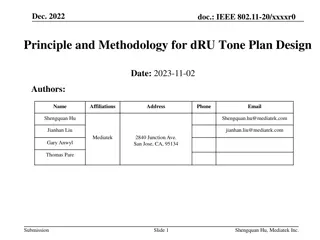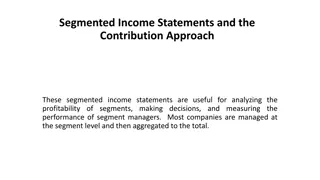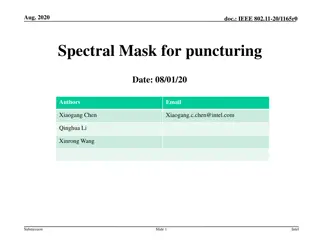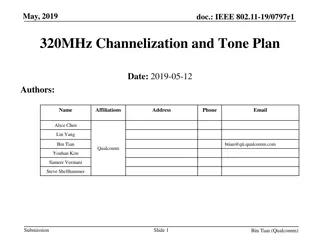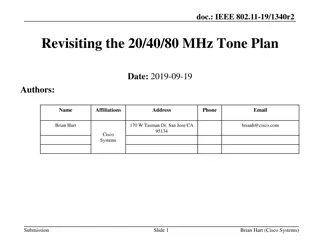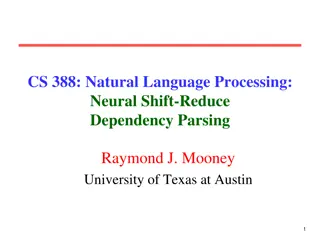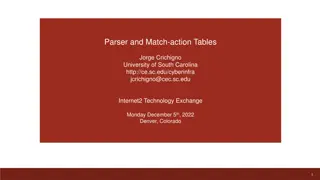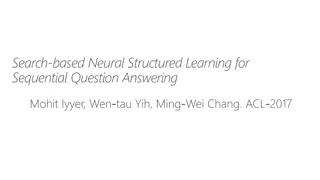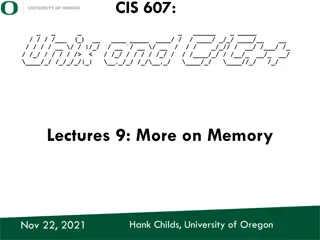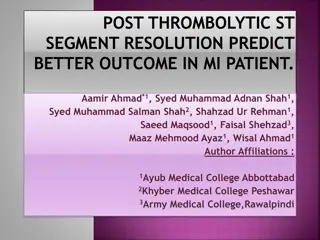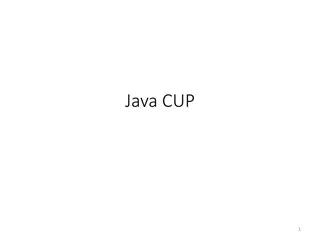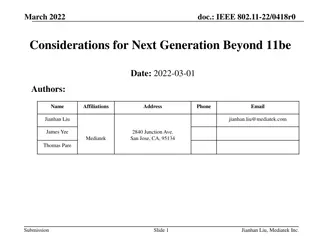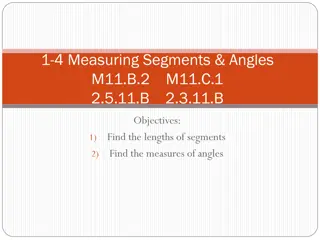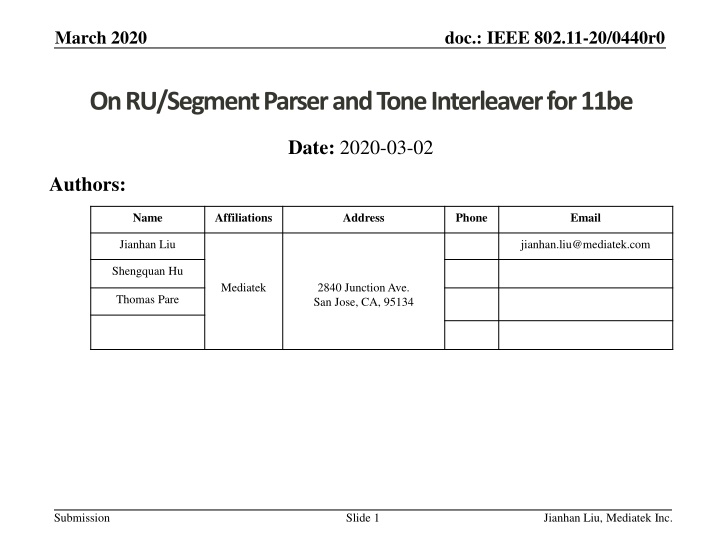
Optimizing Tone Interleave Schemes for RU Aggregations in IEEE 802.11be
This document discusses the development and evaluation of tone interleave schemes for Resource Unit (RU) aggregations in the context of IEEE 802.11be standard. By proposing various tone interleave strategies, the goal is to enhance throughput and performance for different RU configurations. Comparisons between joint tone interleaving and separate tone interleaving are made, focusing on various frequency segments and PPDU sizes. The study highlights the importance of optimizing tone interleaving for improved spectral efficiency in wireless communication systems.
Download Presentation

Please find below an Image/Link to download the presentation.
The content on the website is provided AS IS for your information and personal use only. It may not be sold, licensed, or shared on other websites without obtaining consent from the author. If you encounter any issues during the download, it is possible that the publisher has removed the file from their server.
You are allowed to download the files provided on this website for personal or commercial use, subject to the condition that they are used lawfully. All files are the property of their respective owners.
The content on the website is provided AS IS for your information and personal use only. It may not be sold, licensed, or shared on other websites without obtaining consent from the author.
E N D
Presentation Transcript
March 2020 doc.: IEEE 802.11-20/0440r0 On RU/Segment Parser and Tone Interleaver for 11be Date: 2020-03-02 Authors: Name Affiliations Address Phone Email Jianhan Liu jianhan.liu@mediatek.com Shengquan Hu Mediatek 2840 Junction Ave. San Jose, CA, 95134 Thomas Pare Submission Slide 1 Jianhan Liu, Mediatek Inc.
March 2020 doc.: IEEE 802.11-20/0440r0 Introduction To improve spectral usage, 11be allows more than one RUs to be assigned to a single station (STA) [1]. Small-size RU aggregation and large-size RU aggregation To improve throughput, 240MHz/320MHz PPDU are introduced to 11be. We studied RU and segment parsers and tone interleave schemes for aggregated RU and 240MHz/320MHz PPDU. Evaluate the performance of RU/Segment parser and tone interleaver Our principle is to reuse 11ax segment parser and tone interleaver if there is no performance loss. Submission Slide 2 Jianhan Liu, Mediatek Inc.
March 2020 doc.: IEEE 802.11-20/0440r0 11ax segment parser and LDPC tone mapper for 160/80+80MHz In 11ax, separate tone interleaves are applied on 80MHz frequency segments. Within each 80MHz, just one tone interleaver. Submission Slide 3 Jianhan Liu, Mediatek Inc.
March 2020 doc.: IEEE 802.11-20/0440r0 Tone interleave schemes for RU Aggregations We proposed the following tone interleave schemes for RU aggregations: One joint tone interleaver is applied to combined multiple RUs within one 80MHz frequency segment; Separate tone interleaves are applied on RUs or aggregated RUs in different 80MHz frequency segments. Reasons: Following the tone interleaver scheme defined in 11ac/11ax. For some RU aggregations, such as RU484+RU996, no good DTM can be found for joint tone interleaver schemes. Our simulations show that joint tone interleaver crossing 80MHz segment with optimal DTM have same performance as separated tone interleave. Submission Slide 4 Jianhan Liu, Mediatek Inc.
March 2020 doc.: IEEE 802.11-20/0440r0 Joint Interleave v.s. Separated Tone Interleaver For RU aggregation crossing 80MHz segments and 160/240/320MHz PPDU, we compared the performance of joint tone interleave and separate tone interleave. To get optimal DTM, we allow some tones (Ndrop) are not interleaver. DTM for joint tone interleave crossing 80MHz segment RU combine 484+996 (242+484)+996 484+2*996 484+3*996 2*996 3*996 4*996 vNsd 1448 1682 2428 3408 1960 2940 3920 Dtm Ndrop 38 or (32) or (36) or (30) 41 or (40) or (29) or (35) 55 (or 44) 71 (or 48) 40 60 or (49) 80 or (70) or (56) 4 or (8) or (8) or (8) 1 or (2) or (0) or (2) 8 (or 8) 0 (or 0) 0 0 or (0) 0 Submission Slide 5 Jianhan Liu, Mediatek Inc.
March 2020 doc.: IEEE 802.11-20/0440r0 Example for 484+996 in 160MHz 484+996-tone RU Aggregation tone interleaved within 80MHz Submission Slide 6 Jianhan Liu, Mediatek Inc.
March 2020 doc.: IEEE 802.11-20/0440r0 Options for Segment Parser Sequential parser Sequentially distribute the coded bits to each 80 MHz segments: assign all the coded bits to the 1st 80MHz segment first. After it fills up, move on to the 2nd 80MHz segment, and so on. Round robin parser (11ax method) Start with round robin distribution among all 80MHz segments, NBPSCS/2 coded bits to 80MHz segment 1 followed by NBPSCS/2 to 80MHz segment 2, etc. When a smaller 80MHz segment fills up, all the remaining bits are round robin distributed among remaining larger segments Proportional round robin parser For any RU aggregations, taking ?1 bit-blocks (s) to RU #1, taking ?2 bit-blocks (s) to RU#2 alternatively according to RU-size. m1bit-Blocks for RU #1 m1bit-Blocks for RU #1 m1 bit-Blocks for RU #1 Left-over bit-Blocks for RU with left tones m2 bit-Blocks for RU #2 m2 bit-Blocks for RU #2 m2 bit-Blocks for RU #2 Submission Slide 7 Jianhan Liu, Mediatek Inc.
March 2020 doc.: IEEE 802.11-20/0440r0 Proposed RU/Segment Parser Two factors to evaluate: How ?1 and ?2 affect the performance? How left-over bits affect the performance? Proposed ratio m1:m2:m3:m4 for proportional round robin parser Proportional Ratio (m1:m2:m3:m4) Leftover bits (per symbol) RU Aggregation Nsd_total 484+996 (242+484)+996 484+2*996 484+3*996 2*996 3*996 4*996 1448 1682 2428 3408 1960 2940 3920 1s:2s 3s:4s 1s:2s:2s 1s:2s:2s:2s 1s:1s 1s:1s:1s 1s:1s:1s:1s 44*Nbpscs on ru996 44*Nbpscs on ru996 44*Nbpscs on ru996 44*Nbpscs on ru996 0 0 0 Where: Submission Slide 8 Jianhan Liu, Mediatek Inc.
March 2020 doc.: IEEE 802.11-20/0440r0 Effect of Proportional Ratio Key Observations: Simulations show that the smallest proportion provides the best performance. Submission Slide 9 Jianhan Liu, Mediatek Inc.
March 2020 doc.: IEEE 802.11-20/0440r0 The effect of m1 and m2 on RU996+996 BW160,RU996+996,LDPC,PktLen=4KB,Estimated Channel,B-LOS,2x1, MCS: [9 9], (step-size in unit of s=max(1,Nbpscs/2)) 0 10 step-size (m1:m2)= (1:1): sensSNR=27.36dB step-size (m1:m2)= (20:20): sensSNR=27.35dB step-size (m1:m2)= (245:245): sensSNR=27.33dB step-size (m1:m2)= (490:490): sensSNR=27.94dB step-size (m1:m2)= (980:980): sensSNR=27.99dB -1 10 PER -2 10 26 26.5 27 27.5 28 28.5 29 29.5 SNR (dB) Note: the largest step-size corresponds to sequential parser Submission Slide 10 Jianhan Liu, Mediatek Inc.
March 2020 doc.: IEEE 802.11-20/0440r0 The effect of m1 and m2 on RU484+996 BW160,RU484+996, LDPC,PktLen=4KB,Estimated Channel,B-LOS,4x2, MCS: [7 7],step-size in unit of s=max(1,Nbpscs/2) 0 10 step-size (m1:m2)=(468:980), no leftover: sensSNR=23.89dB step-size (m1:m2)=(117:245), no leftover: sensSNR=23.26dB step-size (m1:m2)=(1:2), with leftover: sensSNR=23.33dB PER -1 10 -2 10 18 19 20 21 22 23 24 25 26 SNR (dB) Note: the largest step-size corresponds to sequential parser Submission Slide 11 Jianhan Liu, Mediatek Inc.
March 2020 doc.: IEEE 802.11-20/0440r0 The effect of m1 and m2 on RU(242+484)+996 BW160,LDPC,PktLen=4KB,RU(242+484)+996,Estimated Channel,B-LOS,2x1, MCS: [5 5 5],(step-size in unit of s=max(1,Nbpscs/2)) 0 10 step-size, (m1+m2):m3=(234+468):980, no leftover: sensSNR=19.56dB step-size, (m1+m2):m3=(117+234):490, no leftover: sensSNR=18.98dB step-size, (m1+m2):m3=(1+2):4, with leftover: sensSNR=18.69dB PER -1 10 -2 10 17 17.5 18 18.5 19 19.5 20 20.5 21 21.5 SNR (dB) Note: the largest step-size corresponds to sequential parser Submission Slide 12 Jianhan Liu, Mediatek Inc.
March 2020 doc.: IEEE 802.11-20/0440r0 Joint Interleave vs. Separate Interleave Observation: Joint tone interleaver crossing 80MHz segment with optimal DTM have same performance as separated tone interleave. Proportional round robin outperforms round robin by 0.2~0.5dB. Submission Slide 13 Jianhan Liu, Mediatek Inc.
March 2020 doc.: IEEE 802.11-20/0440r0 Joint Tone Interleaver Across 80M segment vs Per-80M Segment Tone Interleaver BW240,RU484+996+996,B-LOS,2x1,MCS: [9 9 9],LDPC,Estimated Channel,PktLen=8KB 0 10 joint tone mapper across 80M segment, Dtm=4: sensSNR=28.57dB per-80M segment tone mapper, m1:m2:m3=468:980:980, no leftover: sensSNR=28.41dB per-80M segment tone mapper, m1:m2:m3=117:245:245, no left over: sensSNR=27.78dB per-80M segment tone mapper, m1:m2:m3=1:2:2, with leftover: sensSNR=27.82dB PER -1 10 -2 10 25 25.5 26 26.5 27 27.5 28 28.5 29 29.5 SNR (dB) Submission Slide 14 Jianhan Liu, Mediatek Inc.
March 2020 doc.: IEEE 802.11-20/0440r0 RU484+996, MCS9, 2x1, BF off, B-LOS BW160,RU484+996,B-LOS,2x1,BF off, MCS: [9 9], LDPC,Estimated Channel, PktLen=4KB 0 10 per-80M segment tone mapper with round robin parser(QCOM): sensSNR=32.88dB per-80M segment tone mapper with proportional round robin parser (MTK): sensSNR=32.16dB joint tone mapper across 80M segment with, Dtm=32, Ndrop=8: sensSNR=32.19dB PER -1 10 -2 10 27 28 29 30 31 32 33 34 35 SNR (dB) Submission Slide 15 Jianhan Liu, Mediatek Inc.
March 2020 doc.: IEEE 802.11-20/0440r0 Simulation Results: RU484+996, MCS7, 2x1, BF on, B-LOS BW160,RU484+996,B-LOS,2x1,BF on, MCS: [7 7], LDPC,Estimated Channel, PktLen=4KB 0 10 per-80M segment tone mapper with round robin parser(QCOM): sensSNR=22.63dB per-80M segment tone mapper with proportional round robin parser (MTK): sensSNR=22.43dB joint tone mapper across 80M segment with, Dtm=32, Ndrop=8: sensSNR=22.45dB PER -1 10 -2 10 18 19 20 21 22 23 24 SNR (dB) Submission
March 2020 doc.: IEEE 802.11-20/0440r0 Simulation Results: RU(242+484)+996, MCS7, 4x2, BF on, B-LOS BW160,RU242+484+996,B-LOS,4x2,BF on, MCS: [7 7 7], LDPC,Estimated Channel, PktLen=4KB 0 10 PER -1 10 per-80M segment tone mapper with round robin parser(QCOM): sensSNR=23.50dB per-80M segment tone mapper with proportional round robin parser (MTK): sensSNR=23.29dB joint tone mapper across 80M segment with, Dtm=41, Ndrop=1: sensSNR=23.26dB -2 10 17 18 19 20 21 22 23 24 SNR (dB) Submission
March 2020 doc.: IEEE 802.11-20/0440r0 Simulation Results: RU484+2*996, MCS5, 2x1, BF on, B-LOS BW240,RU996+484+996,B-LOS,2x1,BF on, MCS: [5 5 5], LDPC,Estimated Channel, PktLen=8KB 0 10 per-80M segment tone mapper with round robin parser(QCOM): sensSNR=19.03dB per-80M segment tone mapper with proportional round robin parser (MTK): sensSNR=18.81dB joint tone mapper across 80M segment with, Dtm=55, Ndrop=8: sensSNR=18.80dB PER -1 10 -2 10 15.5 16 16.5 17 17.5 18 18.5 19 19.5 20 SNR (dB) Submission
March 2020 doc.: IEEE 802.11-20/0440r0 Simulation Results: RU484+3*996, MCS5, 1x1, BF off, B-LOS BW320,RU996+484+996+996,B-LOS,1x1,BF off, MCS: [5 5 5 5], LDPC,Estimated Channel, PktLen=8KB 0 10 PER -1 10 per-80M segment tone mapper with round robin parser(QCOM): sensSNR=22.36dB per-80M segment tone mapper with proportional round robin parser (MTK): sensSNR=22.19dB joint tone mapper across 80M segment with, Dtm=71, Ndrop=0: sensSNR=22.18dB joint tone mapper across 80M segment with, Dtm=48, Ndrop=0: sensSNR=22.26dB -2 10 14 15 16 17 18 19 20 21 22 23 24 25 SNR (dB) Submission
March 2020 doc.: IEEE 802.11-20/0440r0 Treatments of left-over tones 1. Sequentially Distribute the leftover bits over last 44 tones on each RU996 To 2nd RU996 To 1st RU996 Leftover bits 2. Proportional Distribute the leftover bits over last 44 tones between RU996 To 1st RU996 To 2nd RU996 Leftover bits 3. Evenly Distribute the leftover bits over each RU996 N iterations Extra m2, m3 N iterations Extra m2, m3 Every N iterations, get one more extra m2 s-blk for 1st RU996, and m3 s-blk for 2nd RU996 Submission Slide 20 Jianhan Liu, Mediatek Inc.
March 2020 doc.: IEEE 802.11-20/0440r0 Simulation Results: RU484+3*996, MCS9, 1x1, BF off, B-LOS BW320,RU484+3*996,B-LOS,1x1,BF off, MCS: [9 9 9 9], LDPC,Estimated Channel, PktLen=8KB 0 10 PER -1 10 sequentially distributed over last 44 tones on RU996: sensSNR=32.31dB proportionally (1:1) distributed over last 44 tones between RU996: sensSNR=32.34dB proportionally (2:2) distributed over last 44 tones between RU996: sensSNR=32.33dB evenly distributed over each RU996: sensSNR=32.24dB -2 10 24 25 26 27 28 29 30 31 32 33 34 SNR (dB) Submission Slide 21 Jianhan Liu, Mediatek Inc.
March 2020 doc.: IEEE 802.11-20/0440r0 Simulation Results: RU484+996, MCS10, 2x1, BF on, B-LOS BW160,RU484+996,B-LOS,2x1,BF on, MCS: [10 10], LDPC,Estimated Channel, PktLen=4KB 0 10 sequentially distributed over last 44 tones on RU996: sensSNR=30.81dB evenly distributed over each RU996: sensSNR=30.83dB PER -1 10 -2 10 29 29.5 30 30.5 31 31.5 32 32.5 SNR (dB) Submission Slide 22 Jianhan Liu, Mediatek Inc.
March 2020 doc.: IEEE 802.11-20/0440r0 Simulation Results: RU484+996, MCS9, 4x2, BF on, B-LOS BW160,RU484+996,B-LOS,4x2,BF on, MCS: [9 9], LDPC,Estimated Channel, PktLen=4KB 0 10 sequentially distributed over last 44 tones on RU996: sensSNR=28.43dB evenly distributed over each RU996: sensSNR=28.42dB PER -1 10 -2 10 25 25.5 26 26.5 27 27.5 28 28.5 29 29.5 SNR (dB) Submission Slide 23 Jianhan Liu, Mediatek Inc.
March 2020 doc.: IEEE 802.11-20/0440r0 Summary We evaluate the performance of joint tone interleave and separate tone interleave for each 80MHz segment. We evaluate the different segment parser for multi-RU aggregation and large BW. Conclusions: Joint tone interleave crossing 80MHz segment has almost the same performance as proportional round robin. Joint tone interleave crossing 80MHz segment requires significant architecture change. Proportional round robin outperforms round robin by 0.2~0.5dB. Different treatments for left-over bits for some RU aggregations have no impact on performance. To make it simple, same proportional round robin is applied to left-over bits. Submission Slide 24 Jianhan Liu, Mediatek Inc.
March 2020 doc.: IEEE 802.11-20/0440r0 Straw Poll #1 Do you agree the following LDPC tone interleaver scheme for multi- RU aggregation in 11be? One joint tone interleaver is applied to aggregated RUs within one 80MHz frequency segment. For aggregated RUs and PPDU BW crossing 80MHz segment boundary, separate tone interleaver is applied in each 80MHz. Submission Slide 25 Jianhan Liu, Mediatek Inc.
March 2020 doc.: IEEE 802.11-20/0440r0 Straw poll #2 Do you agree that 11be uses 80HMz segment parser with the following proportional round robin scheme? Proportional Ratio (m1:m2:m3:m4) Leftover bits (per symbol) RU Aggregation Nsd_total 484+996 (242+484)+996 484+2*996 484+3*996 2*996 3*996 4*996 1448 1682 2428 3408 1960 2940 3920 1s:2s 3s:4s 1s:2s:2s 1s:2s:2s:2s 1s:1s 1s:1s:1s 1s:1s:1s:1s 44*Nbpscs on ru996 44*Nbpscs on ru996 44*Nbpscs on ru996 44*Nbpscs on ru996 0 0 0 Where: Submission Slide 26 Jianhan Liu, Mediatek Inc.
March 2020 doc.: IEEE 802.11-20/0440r0 Straw Poll #3 Do you agree the same proportional round robin is applied to left-over bits? The same ratios are used in the entire segment parsing process except the ratios of those already filled segment becomes 0. To 1st RU To 2nd RU Leftover bits Submission Slide 27 Jianhan Liu, Mediatek Inc.


